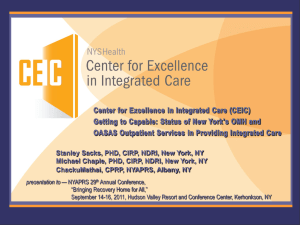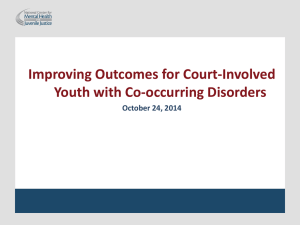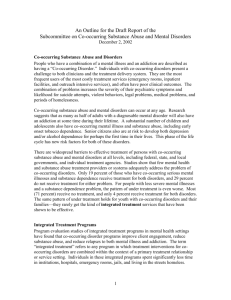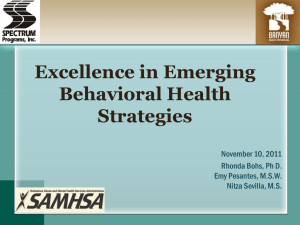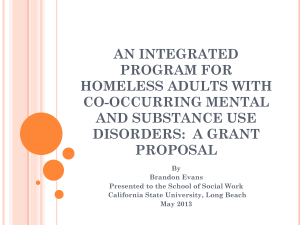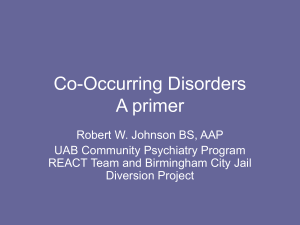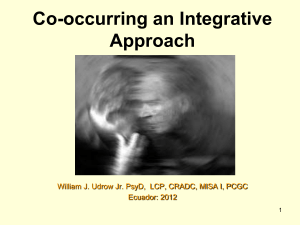Innovations in Integrated Treatment for Co
advertisement
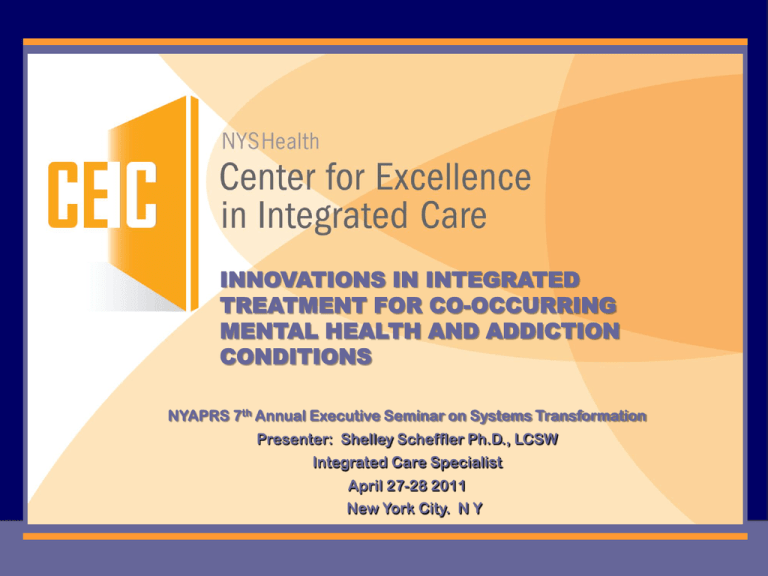
INNOVATIONS IN INTEGRATED TREATMENT FOR CO-OCCURRING MENTAL HEALTH AND ADDICTION CONDITIONS NYAPRS 7th Annual Executive Seminar on Systems Transformation Presenter: Shelley Scheffler Ph.D., LCSW Integrated Care Specialist April 27-28 2011 New York City. N Y Introduction Title: Location: Center for Excellence in Integrated Care Funded by: New York State Health Foundation In coordination with: New York State (NYS) Offices of Mental Health (OMH) and of Alcoholism & Substance Abuse Services (OASAS) NDRI Start Date: November 1, 2008 Period: 4 years 2 •What does CEIC do? •Provides technical assistance (hands-on, intensive, and longitudinal) Engages Leadership Performs on-site assessments Presents site reports Conducts provider forums Builds collaborations and informal networks Holds Peer Recovery Workshops Supplies ongoing support, guidance, and consultation 3 WHY DO WE NEED TO MEASURE CO-OCCURRING CAPABILITY? Generic terms like “integrated care” amount to “feel good” rhetoric but lack specificity. Full integration (a clinician or program fully treating both mental health and substance use conditions) is often presented as the only model of integration. In reality, programs who’s history and culture are much closer to substance abuse or mental health only are more likely to move towards more intermediate levels of integration (co-occurring capable) Ultimately we will have a system with a range of levels of integration (capable to enhanced ) 4 COD Enhanced COD Capable Fully Integrated COD Integrated COD Enhanced Addiction Only Tx Building Co-occurring Capability OMH / OASAS COD Targets • COD Screening • COD Domains of Assessment • COD Evidence Based Practices 5 •CEIC Assessment Methods Uses DDCA[MH]T Samples individual clinics within regions Employs direct onsite observation Scores and reports on 7 domains separately and in total 6 Levels of Capability (DDCAT or DDCMHT survey) LEVELS OF CAPABILITY DIMENSIONS OF CAPABILITY S.A./M.H.ONLY CAPABLE ENHANCED I Program Structure Program mission, structure and financing, format for delivery of co-occurring services. II Program Milieu Physical, social and cultural environment for persons with mental health and substance use problems. III Clinical Process: Assessment Processes for access and entry into services, screening, assessment & diagnosis. IV Clinical Process: Treatment Processes for treatment including pharmacological and psychosocial evidence-based formats. V Continuity of Care Discharge and continuity for both substance use and mental health services, peer recovery supports. VI Staffing Presence, role and integration of staff with mental health and addiction expertise, supervision process VII Training Proportion of staff trained and program’s training strategy for co-occurring disorder issues. 7 • Dual Disorder Capability •Enhanced • (N=251) •closer to Capable than to Basic •Capable •Basic •3.06 •3.05 •2.71 •Total Score •2.74 •2.5 •Program Structure •2.53 •2.53 •Program •Screening & •Treatment •Continuity Milieu Assessment of Care •2.5 2 •Staffing •Training •Scores based on DDCA[MH]T = Dual Diagnosis Capability in addiction [Mental Health] Treatment Index 8 Observations The outpatient system has moved away from addiction and mental health only status, and is moving towards co-occurring capable levels of care. The outpatient mental health system is repositioning itself to provide services for mild to moderate levels of substance abuse. (Quadrant 2: high mental health – mild to moderate substance abuse) The outpatient substance abuse treatment system is repositioning itself to provide services for mood and anxiety conditions. (Quadrant 3: high substance abuse – mild to moderate mental health) Consumers with high severity of mental health and addiction (Quadrant 4: high substance abuse – high mental health) still have very few service options, however more integrated collaborations between substance abuse and mental health clinics have the potential to address this significant gap. 9 Issues for consideration With an average score of 2.71 the OASAS and OMH outpatient system is moving towards a co-occurring capable level of service integration. The two systems are remarkably close in their capability scores2.76 OASAS, 2.67 OMH- the staffing domain is the only area with any statistical significance. Its now feasible to consider that in time, a baseline of co-occurring capable is achievable across the two systems. As programs who are currently in the midrange ( 2.71), move to capable status there will be further movement of those currently capable (3.00 3.66), to more enhanced levels of care, however greater resources are required to accomplish the latter 10 Issues for consideration Programs who have undertaken a measure of their current co-occurring capability using the DDCAT or DDCMHT are in a better position to target specific areas requiring co-occurring competency building training. Programs who have undertaken a measure of their current co-occurring capability using the DDCAT or DDCMHT and then implement recommendations to increase capability can use the same tool to guide their evaluation of outcomes of changes in their capability The results of each survey provides individual programs with possible recommendations for increasing their co-occurring capability. The aggregate trends that emerge from all programs surveyed across the state will assist decision makers in identifying larger issues of systemic change that could be considered for advancing capability. 11 Key issues for building capability Not all programs have implemented a recommended co-occurring screener and when implemented many programs lack a clear protocol when a positive cut-off score is determined. Stage-wise assessment and treatment has not been incorporated into most programs. Specialized interventions with either mental health or substance abuse content are variable in treatment schedules and in a number of cases non-existent. The systematic inclusion of peer recovery support positions for patients with cod is a significant issue for most programs with the majority rating poorly on the survey 12 Key issues for building capability Out patient programs vary considerably from those that offer core components of treatment to those where treatment is driven almost entirely by individual clinician preference. In the case of the latter it is proving far more difficult to implement programmatic change The implementation of recommended co-occurring evidence-based practices at a programmatic level is at its infancy. This also is consistent with a system that is moving from “only to capable” For many programs the next step in capability building will be to increase either the mental health or the substance abuse content of their existing treatment regimes rather than the implementation of a specific cod evidence based practice. 13 •"CEIC receives support (awards 208-2496857 & 2009-3426912) from the New York State Health Foundation (NYSHealth)." Contact Information Center for Excellence in Integrated Care (CEIC) 71 W 23rd Street, 8th Floor New York, NY 10010 tel 212.845.4400 fax 212.845.4650 www.nyshealth-ceic.org CEIC receives support (awards 208-2496857 & 2009-3426912) from the New York State Health Foundation (NYSHealth) 14


